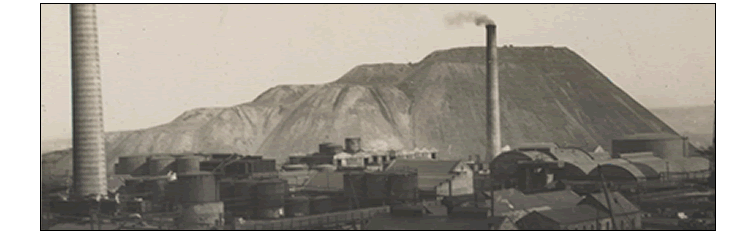
Everyone is familiar with fossil fuels such as coal, oil and gas. Shale oil is an unusual form of fossil fuel that was produced from oil-shales mined in West Lothian. James "Paraffin" Young's works in Bathgate were the first in the world to produce and refine oil, and shale oil continued to be produced in West Lothian until 1962.
Oil-shale is a hard, shiny, sedimentary rock which contains the remains of microscopic creatures that lived over 300 million years ago. It is a fossil fuel. When this rock is crushed and heated, a crude oil is released, very much like the crude oil produced from oil wells in many parts of the world. This crude oil was processed at a refinery to produce many different kinds of oil, wax and grease. In West Lothian, detergents and bricks were also produced as a by-product of shale oil production.
Oil-shale was mined from deep beneath the eastern part of West Lothian. Particularly productive shales were found around West Calder, Deans, Pumpherston and Broxburn. The shale was brought to the surface and taken to a crude oil works, where it was heated in a "retort" to release crude oil and other useful chemicals. The crude oil was then taken by railway to a refinery where many oil products were produced. The largest of these refineries was at Pumpherston.

The Scottish shale oil industry began in 1850, when James "Paraffin" Young invented a process for obtaining oil from a special kind of coal. This created a world-wide demand for paraffin that could be burned in oil lamps. In 1864 Young began construction of a new works at Addiewell which used oil-shale for producing oil. The success of these works inspired many others to enter the oil business, and new oil works were built in many parts of West Lothian.
At the start of the 20th century, the shale oil industry was very profitable and much was invested in new works, new mines and new villages to house those the workforce. This changed suddenly after the first world war Britain began importing crude oil from oil wells in Arabia and other overseas countries. This imported crude oil was much cheaper than oil produced from oil-shale, and many shale oil works were forced to close. To prevent mass unemployment, the goverment introduced a subsidy on shale oil products, and invested in new mines and a new oilworks prior to the second world war. The industry finally closed in 1962 after the government decided to remove the subsidy.
There are still many reminders of this famous industry. Many of the red shale bings, made from the waste material produced at crude oil works, still survive. A few are now preserved as monuments. Many of the houses built to house the shale oil workers and their families also survive and have been modernised to provide good solid homes.
Little oil-shale remains beneath West Lothian and it seems unlikely that shale will ever be mined here again. There are however other places in the world where huge reserves of oil-shale exist. These are likely to be used to produce crude oil as supplies from oil wells become exhausted.